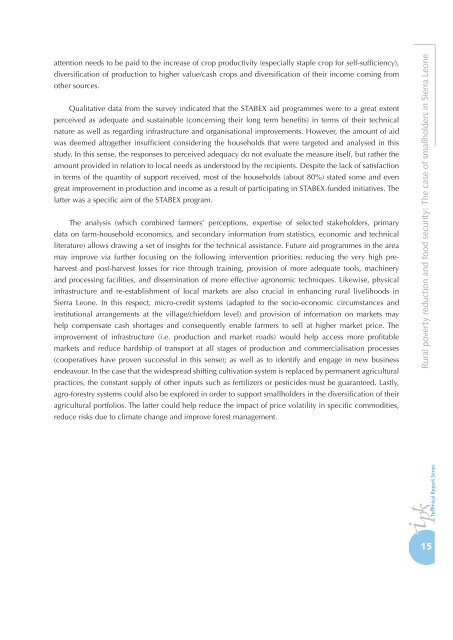SIERRA LEONE maq 4ª.indd - agrilife - Europa
SIERRA LEONE maq 4ª.indd - agrilife - Europa
SIERRA LEONE maq 4ª.indd - agrilife - Europa
Create successful ePaper yourself
Turn your PDF publications into a flip-book with our unique Google optimized e-Paper software.
attention needs to be paid to the increase of crop productivity (especially staple crop for self-sufficiency),<br />
diversification of production to higher value/cash crops and diversification of their income coming from<br />
other sources.<br />
Qualitative data from the survey indicated that the STABEX aid programmes were to a great extent<br />
perceived as adequate and sustainable (concerning their long term benefits) in terms of their technical<br />
nature as well as regarding infrastructure and organisational improvements. However, the amount of aid<br />
was deemed altogether insufficient considering the households that were targeted and analysed in this<br />
study. In this sense, the responses to perceived adequacy do not evaluate the measure itself, but rather the<br />
amount provided in relation to local needs as understood by the recipients. Despite the lack of satisfaction<br />
in terms of the quantity of support received, most of the households (about 80%) stated some and even<br />
great improvement in production and income as a result of participating in STABEX-funded initiatives. The<br />
latter was a specific aim of the STABEX program.<br />
The analysis (which combined farmers’ perceptions, expertise of selected stakeholders, primary<br />
data on farm-household economics, and secondary information from statistics, economic and technical<br />
literature) allows drawing a set of insights for the technical assistance. Future aid programmes in the area<br />
may improve via further focusing on the following intervention priorities: reducing the very high preharvest<br />
and post-harvest losses for rice through training, provision of more adequate tools, machinery<br />
and processing facilities, and dissemination of more effective agronomic techniques. Likewise, physical<br />
infrastructure and re-establishment of local markets are also crucial in enhancing rural livelihoods in<br />
Sierra Leone. In this respect, micro-credit systems (adapted to the socio-economic circumstances and<br />
institutional arrangements at the village/chiefdom level) and provision of information on markets may<br />
help compensate cash shortages and consequently enable farmers to sell at higher market price. The<br />
improvement of infrastructure (i.e. production and market roads) would help access more profitable<br />
markets and reduce hardship of transport at all stages of production and commercialisation processes<br />
(cooperatives have proven successful in this sense); as well as to identify and engage in new business<br />
endeavour. In the case that the widespread shifting cultivation system is replaced by permanent agricultural<br />
practices, the constant supply of other inputs such as fertilizers or pesticides must be guaranteed. Lastly,<br />
agro-forestry systems could also be explored in order to support smallholders in the diversification of their<br />
agricultural portfolios. The latter could help reduce the impact of price volatility in specific commodities,<br />
reduce risks due to climate change and improve forest management.<br />
Rural poverty reduction and food security: The case of smallholders in Sierra Leone<br />
15
















